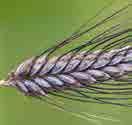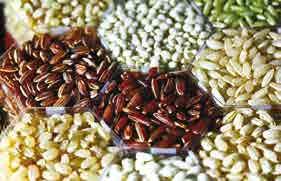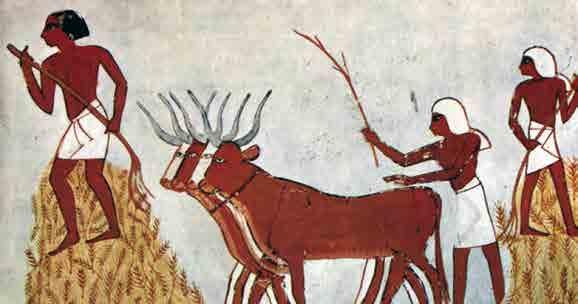Why We Eat Maize , Wheat, Rice , and P otatoes



Why We Eat Maize , Wheat, Rice , and P otatoes
More science titles from Nomad Press




Check out more titles at www.nomadpress.net
Nomad Press
A division of Nomad Communications
10 9 8 7 6 5 4 3 2 1
Copyright © 2024 by Nomad Press. All rights reserved.
No part of this book may be reproduced in any form without permission in writing from the publisher, except by a reviewer who may quote brief passages in a review or for limited educational use. The trademark “Nomad Press” and the Nomad Press logo are trademarks of Nomad Communications, Inc.
ISBN Softcover: 978-1-64741-115-2
ISBN Hardcover: 978-1-64741-112-1
Educational Consultant, Marla Conn
Questions regarding the ordering of this book should be addressed to Nomad Press PO Box 1036, Norwich, VT 05055 www.nomadpress.net
CONTENTS
Timeline
How Does a Seed Grow?
Introduction Seeds, Seeds, Everywhere!
Chapter 1 First Farmers, First Crops
Chapter 2 Maize
Chapter 3 Wheat
Chapter 4 Rice .
Chapter 5 Potatoes .
Chapter 6 Endangered Seeds
Glossary • Metric Conversions
Essential Questions • Resources Index
Interested in Primary Sources? Look for this icon.
Some of the QR codes in this book link to primary sources that offer firsthand information about the topic. Many photos are considered primary sources as well because a photograph takes a picture at the moment something happens. Use a smartphone or tablet app to scan the QR code and explore more! You can find a list of the URLs on the Resources page. You can also use the suggested keywords to find other helpful sources. seeds
. .
. iv
. . .
vi
. . .
1
. . .
9
. .
. 26
.
.
. 49
. . 66
. . 83
. . . 99



10,000 BCE: People begin domesticating plants, including einkorn and emmer wheat, in the Fertile Crescent.
8000 to 7000 BCE: Wild teosinte grows in the Americas. People begin domesticating teosinte into a crop that will eventually become maize.
7000 to 6000 BCE: Chinese farmers begin to domesticate rice.
8000 to 5000 BCE: Farmers begin to domesticate potatoes in the Andes Mountains of South America.
2000 BCE to 900 CE: Maya civilization, fueled by maize, reaches its peak.
468 BCE: The Chinese build the Grand Canal to transport rice and other materials between southern and northern regions.
1200 CE: The Inca form a kingdom in the Andes Mountains and begin building an empire with the potato as a staple food.
1325: The Aztec found the city of Tenochtitlan on the site of today’s Mexico City and rely on maize to feed their population.
1493: European explorer Christopher Columbus returns to Europe with maize.
1500s: Maize and potatoes spread through Europe. European explorers bring wheat and rice to the Americas.
Early 1800s: The U.S. Secretary of the Treasury directs U.S. ambassadors and military officers to gather seeds and seed data from their posts worldwide.
1800s: The Industrial Revolution brings new machines that make farming more efficient, including the mechanical reaper, mechanical thresher, and steel plow.
THE SCIENCE OF SEEDS vi TIMELINE



1845: The potato blight reaches Ireland, and the Irish Potato Famine begins. It lasts until 1851. Millions of people die or flee the country.
Early 1900s: Maize shows become a popular social event in the U.S. Corn Belt.
1920s: Russian agricultural scientist Nikolai Vavilov researches crop centers of origin. He creates the world’s first seed bank in Leningrad in the Soviet Union.
1922: The first hybrid maize is produced and sold commercially.
1940s: American scientist Norman Borlaug develops a new hybrid wheat variety that is able to produce higher yields and resist disease. The Green Revolution begins a period of initiatives to greatly increase crop yields and production.
1960: The International Rice Research Institute is formed and begins work on a hybrid rice plant that will produce higher yields. It creates IR8, which is nicknamed the “miracle rice” and significantly increases yields.
1990s: The first genetically modified organism (GMO) crops, including maize and potatoes, are created through genetic engineering.
2008: The Svalbard Global Seed Vault opens in Norway.
2010s: Independent seed companies emerge to meet the increasing demand for organic seeds in the United States.
2021: The United States is the world’s largest producer of maize, producing 15.1 billion bushels.
2023: About 75 percent of the world’s food comes from just 12 plant and five animal species.
vii TIMELINE
THE SCIENCE OF SEEDS HOW DOES A SEED GROW?
Everything a plant needs to grow is inside its seed—just add light, warmth, and nutrients! Inside the seed, a part called the embryo contains the radicle, plumule, and cotyledons. The radicle becomes the plant’s first root. The plumule grows as the plant’s first shoot, which becomes the stem. The cotyledons are the plant’s first leaves. They contain enough food for the young plant to survive until it has plenty of leaves to produce its own food through photosynthesis
Photosynthesis is how plants convert light into energy. They also need water and carbon dioxide. And their waste product? Oxygen! That’s why plants and trees are vital to all other life on earth—and to the health of the planet.
When it grows into an adult, the plant will have flower blossoms to attract pollinators to fertilize new seeds and the life cycle will continue!
RADICLE
EMBRYO
COTYLEDON
PLUMULE
viii
HOW DOES A SEED GROW?
WORDS TO KNOW
SUNLIGHT
CARBON DIOXIDE WATER
OXYGEN
embryo: an organism at its earliest stage of development.
radicle: the first part of a plant embryo that emerges and forms a root.
plumule: the part of a plant embryo that forms a shoot.
cotyledon: the first leaves produced by a seed.
photosynthesis: the process by which plants produce food, using light as energy.
ix
Contents
SEEDS, SEEDS, EVERYWHERE!



Maize , wheat, rice, and potatoes. From Lagos to Los Angeles, these four staple foods can be found in our breakfast cereals, lunch boxes, and on our dinner tables. The foods we love would not be the same without these four staple foods. What would a Rice Krispie Treat taste like without rice? Without potatoes, you would have no crispy French fries to dip in ketchup. And your burrito would be hard to hold without corn or wheat to make tortillas! How did we come to rely so much on these four foods?
ESSENTIAL QUESTION
Why do we rely on so few staple crops in a world of agricultural diversity?
Since our earliest days, plants have been essential to the human diet. Today, we have more than 50,000 edible plant species on Earth, an incredible diversity. Yet only a few hundred plants make up a significant part of our diet. And just 15 plants provide 90 percent of the calories we eat. Of those, “the big four” crops maize, wheat, rice, and potatoes—are staple foods for about 5 billion people. These big four crops are stable and widespread. Even in changing climate conditions, we rely on them to feed the majority of humans.
Introduction
1
WORDS TO KNOW
maize: a Central American cereal plant, also known as corn.
staple food: a food that is an essential part of our diet.
edible: can be eaten.
diversity: a range of different people or things.
calorie: a unit of energy in food.
crops: plants grown for food and other uses.
climate: the long-term weather pattern in a region.
nutrition: the vitamins, minerals, and other things in food that your body uses to stay healthy and grow.
agriculture: the science or practice of farming.
malnutrition: poor nutrition caused by not eating the right foods.
nutrient: a substance in food and soil that living things need to live and grow.
WHAT ARE STAPLE FOODS?
A staple food is a food that is a significant part of a population’s diet. People eat staple foods regularly, often daily. These foods provide a large portion of the calories and nutrition a person needs.
Many staple foods come from plants. They are inexpensive and provide a lot of calories to give us energy. Beyond maize, wheat, rice, and potatoes, other staple foods include millet, sorghum, cassava, and yams. Not all staple foods are plants. Animal products such as meat, fish, and dairy are also staple foods.
A staple food in one region may not be as crucial for people living in another region. For example, millet, rice, and soybeans are staple foods in China. In Mexico, maize and potatoes are more common staple foods. For centuries, a region’s staple foods were linked to the plants and crops that could grow nearby.


2
THE SCIENCE OF SEEDS
However, improvements in agriculture and transportation now allow staple foods to spread to new places worldwide. Have you ever had quinoa? Quinoa is a grain-like plant grown in the Andes Mountains in South America. Today, people as far away as North America, Europe, Asia, and Africa enjoy eating quinoa.
Staple foods are nutritious but do not provide all the nutrition people need. To avoid malnutrition, people must eat foods with other nutrients .
The Scientific Method
A scientific method worksheet is a useful tool for keeping your ideas and observations organized. The scientific method is the process scientists use to ask and answer questions. Use a notebook as a science journal to make a scientific method worksheet for each experiment.
Question: What are we trying to find out? What problem are we trying to solve?
Research: What is already known about this topic?
Hypothesis: What do we think the answer will be?
Equipment: What supplies are we using?
Method: What procedure are we following?
Results: What happened and why?


credit: International Rice Research Institute (CC BY 2.0)
3 seeds, seeds, everywhere!
WORDS TO KNOW
evolution: gradual change across many years.
civilization: a complex human society.
cultivate: to raise and grow plants for food.
hunter-gatherer: a nomadic person who lives by hunting, fishing, and collecting food. forage: to search widely for food.
proteins: nutrients that are essential to the growth and repair of cells in the body.
fats: nutrients that are essential to give your body energy and support cell function.
carbohydrates: nutrients that are an important source of energy.
nomadic: a lifestyle that involves moving from place to place.
anthropologist: a scientist who studies humans and human behavior.
harvest: to gather crops. environment: everything in nature, living and nonliving, including plants, animals, soil, rocks, and water.
germinate: to sprout or begin to grow.
THE SCIENCE OF SEEDS
A CONNECTED HISTORY
The big four staple foods do more than feed people worldwide. These top crops have also played a role in the evolution of human civilization. The history of humans and the crops we grow have been interconnected for thousands of years.
Staple foods supported the first human civilizations—wheat and barley in the Near East, rice and millet in Asia, and maize and potatoes in the Americas. And they did not grow by accident. Instead, humans purposely cultivated these crops. In doing so, people transformed these crops from wild plants into the staple foods we enjoy today. And with these crops, our human ancestors evolved from hunters and gatherers to early farmers. These changes took place slowly across many generations.
LIFE AS A HUNTER-GATHERER
Hunting and gathering was a way of life for most of human history. In fact, until about 12,000 years ago, all humans were hunter-gatherers. Huntergatherers hunted and fished for meat. They foraged for plants, seeds, berries, fruits, and vegetables to eat. Hunter-gatherers ate a variety of foods that contained a wide range of nutrients. Meats, fish, and plants provided proteins , fats , carbohydrates , and nutrients.
TEXT TO WORLD
Imagine what your life would be like as a hunter-gatherer. How would you find food where you live? What could you hunt or fish? What plants could you gather to eat?
4
Hunter-gatherers were very active. They traveled across large areas of land to find the food they needed. They were nomadic . But imagine if your entire neighborhood had to travel together all the time to gather food—that’s too many people! Nomadic groups had to be smaller. Some included only the members of an extended family. Others were larger and included multiple families. However, few groups had more than about 100 people.
Anthropologists and other scientists who have studied hunter-gatherer groups believe they accumulated a vast knowledge of the natural world. And they used that knowledge to survive. They could identify edible plants and knew which parts of the plant could be eaten. They understood when plants sprouted, bloomed, and were ready to harvest . They knew when animals and birds mated and had their young. They were able to extract medicines and poisons from plants. They used plant fibers to make clothing, baskets, and other objects.
As early as about 12,000 years ago, humans lived on all continents except Antarctica.
Hunter-gatherers also learned to manage their environment . For example, they set controlled fires to eliminate weeds and insects. The fires also helped seeds with hard shells such as pine nuts, chestnuts, and walnuts to germinate. More germinating seeds meant more seed-producing, edible plants. After the fires, new grass grew and attracted animals for grazing.
ADOPTING AGRICULTURE
For thousands of years, humans survived by hunting, fishing, and foraging. Then, about 12,000 years ago, evidence shows that nomadic human tribes began to use tools that allowed them to grow and cultivate their food. The gradual adoption of agriculture and farming has enormously impacted our human story.
5 seeds, seeds, everywhere!
THE SCIENCE OF SEEDS
WORDS TO KNOW
tuber: the thick part of the stem, usually developed underground, of certain plants such as potatoes.
domesticate: to adapt a plant or animal from a wild state to benefit humans.
migrate: to move from one region to another.
With agriculture, early humans no longer needed to travel far and wide for food. The traditional hunter-gatherer lifestyle, which humans had always followed, was slowly replaced. Humans grew crops and had a reliable food source. Permanent settlements were established near farmlands.
As time went on, settlements grew into towns and cities. And because farms could produce enough food to feed more people, the number of people skyrocketed. About 10,000 years ago, about 5 million people lived on Earth. Today, more than 8 billion humans live on our planet.
Scientists cannot point to a single reason why hunter-gatherer groups adopted farming. Another mystery is how people living in different parts of the world, who had no contact with each other, independently adopted agriculture. In the Near East, evidence of early farming of wheat dates back 11,000 to 12,000 years. People began growing rice 9,000 years ago in China’s Yellow River Valley. African people grew tubers and roots around 5,000 to 8,000 years ago. And in South America, people began growing maize, beans, and squash between 7,000 and 9,000 years ago.
The Hadza of Tanzania
In Africa, the Hadza people of northern Tanzania still rely on hunting and gathering to survive. They have no domesticated livestock and do not grow their own food. Instead, they hunt game with handmade bows and arrows and forage for tubers, plants, and honey. Because they follow a nomadic lifestyle, they do not have permanent homes. Instead, the Hadza build temporary shelters from dried grass and branches. They own few possessions, which makes it easier to move to a new camp. Today, there are about 1,300 Hadza tribe members. They are one of the last hunter-gatherer tribes in Africa.
6

A TURNING POINT
The gradual shift from hunting and gathering to agriculture was a turning point in human history. In places across the globe, people without contact with each other began to grow crops. They grew crops suited to their specific climate and environment. When they migrated to new regions, they brought their crops and seeds with them. As they met new people, groups began to trade with each other. Seeds, crops, and agriculture spread to new places.
The story of top crops—maize, wheat, rice, and potatoes—is closely intertwined with early humans and their first agricultural efforts. Where did these crops come from? How did humans cultivate them? And how did these crops become so important to human history? Let’s investigate and find out how these crops came to shape our world.
7 seeds, seeds, everywhere!
Ancient Egyptians used oxen to help with the work of growing and harvesting food.
WHAT’S IN THE PANTRY?
Maize, wheat, rice, and potatoes are four of the most common staple crops in the world. But how common are these foods in your home? How much of what you like to eat depends on these four top crops?
› Take an inventory of the food in your kitchen pantry, cabinets, and refrigerator. Make a list of everything you find.

› After you have your list of food, place each into a food category: corn, wheat, rice, or potato. You can add some additional categories, such as dairy, fruits and vegetables, and meat. Look at the list of ingredients on boxes and cans to determine if they contain any staple foods.
› Once you have sorted the food by category, think about the following questions.
» What staple food did you find the most?
» What staple food did you find the least?
» Did you find any foods that did not fit into any of your categories? What were they?
› Based on what you found, consider how much your family relies on staple foods. Is it a lot?
Consider This!
If one of the four top crops was no longer available, what foods would you not be able to eat? How would you replace these foods in your diet? What substitutions could you make?
Essential Questions
Each chapter of this book begins with an essential question to help guide your exploration of seeds. Keep the question in your mind as you read the chapter. At the end of each chapter, use your science journal to record your thoughts and answers.
ESSENTIAL QUESTION
Why do we rely on so few staple crops in a world of agricultural diversity?
8






















